#snail shell fossil
Explore tagged Tumblr posts
Text


6 larger Turritella fossils spiral snail shell gastropod internal molds
#turritella#snail shell#gastropod#gastropods#mold fossil#spiral#snail shell fossil#fossil#fossils#fossilized#png#transparent#paleontology#prehistoric#paleoblr
118 notes
·
View notes
Text
A little distraction on a somewhat stressful day: a neat rock that my sister found and gave to me, and a snail shell I found! (Also, if anyone knows anything about fossils and recognizes these, please let me know!)






#rocks#fossils#snails#shell#bugs#(all of the bug people i know also like rocks and shells)#(and some of the fossil imprints look like isopods to me)#goblincore
22 notes
·
View notes
Photo

Rare 6.5" Crioceratites nolani Heteromorph Fossil Ammonite, Hauterivian, Cretaceous: Alpes-de-Haute-Provence, France
This rare 6.5-inch Crioceratites nolani heteromorph ammonite fossil is an exceptional specimen from the Hauterivian stage of the Early Cretaceous period, dating back approximately 130-135 million years. Discovered in Alpes-de-Haute-Provence, France, this fossil showcases the coiled yet irregular shell structure characteristic of heteromorph ammonites, making it a unique and fascinating addition to any collection.
Crioceratites nolani is a notable species within the Crioceratidae family, celebrated for its spirally coiled, open-shell morphology. These ammonites thrived in marine environments and are often used to study evolutionary adaptations in ammonite lineages.
Key Features:
Species: Crioceratites nolani
Geological Period: Early Cretaceous, Hauterivian stage (~130-135 million years ago)
Location: Alpes-de-Haute-Provence, France
Size: 6.5 inches (see scale rule in photos for exact dimensions)
Shell Morphology: Open-coiled, irregular spiral showcasing the distinct features of heteromorph ammonites.
Provenance: From the world-renowned Alice Purnell Collection, recognized as one of the largest and most prestigious collections of ammonites globally.
Certificate of Authenticity Included:
This fossil is guaranteed 100% genuine and comes with a Certificate of Authenticity to ensure the authenticity and value of your purchase. The exact specimen shown in the photos will be the one you receive, providing transparency and confidence in your investment.
Why This Fossil is Exceptional:
Heteromorph Shell Structure: The unusual, open-coiled morphology of Crioceratites nolani makes it a standout fossil for collectors and researchers alike.
Rare Species: Fossils of Crioceratites nolani are highly sought after due to their unique structure and rarity in fossil beds.
Educational Value: An excellent specimen for understanding ammonite evolution, particularly the adaptations of heteromorph species.
Historic Provenance: Part of the esteemed Alice Purnell Collection, offering a legacy of careful curation and paleontological significance.
Ideal for Collectors and Enthusiasts:
Whether you’re a seasoned fossil collector, a paleontology enthusiast, or an educator, this Crioceratites nolani fossil is a remarkable piece of Earth’s natural history. Its striking appearance and scientific importance make it a worthy addition to any collection or display.
Don’t miss the chance to own this rare and beautifully preserved fossil, representing the incredible diversity of marine life during the Early Cretaceous period. Add it to your collection today!
#ammonite#ammonites#fossils#fossil#genuine specimen#sea fossil#marine animal#amonite#snail shell#fossil specimen
5 notes
·
View notes
Text

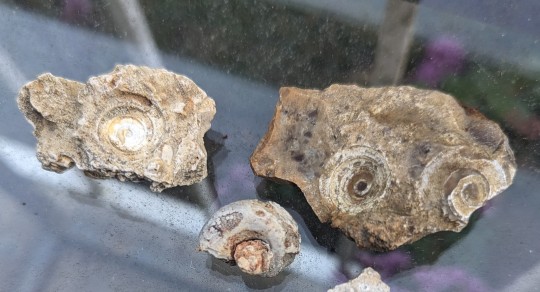
It's already shaping up to be a good vacation :)
39 notes
·
View notes
Text

Spiral Shell by Technodrome1
6 notes
·
View notes
Text
On the higher parts of the island, considerable numbers of a shell, long thought a marine species, occur embedded in the soil.
"Journal of Researches into the Natural History and Geology of the Countries Visited During the Voyage of H.M.S. Beagle Round the World, 1832-36" - Charles Darwin
#book quote#the voyage of the beagle#charles darwin#nonfiction#saint helena#island#shells#fossils#geology#snail shell#cochlogena#helix#land snail
0 notes
Text
I'm back from the rock show! Here are the Cool Rocks I got!
Let's start with the fossils this time.


This year I finally tracked down a Tully Monster, which is my state fossil! He's not a complete fossil, but you can see his eyestalk and the bottom of his proboscis very clearly.

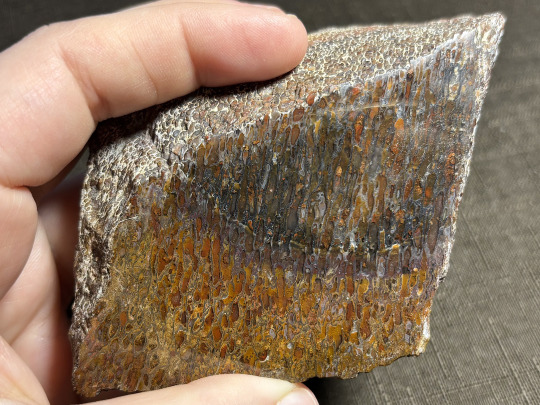
A big chunk of dinosaur bone from Utah! Dino bone is easy to ID due to its distinct pattern, where agate and jasper have filled in the porous structure of the bone.

This is a coprolite, a piece of fossilized dinosaur poop! This one is from Madagascar.

This one is a stromatolite, a rock formation created by a colony of bacteria! Stromatolites are some of the oldest fossils on Earth. In fact, the microbes that make them were likely the very first lifeforms on the planet. And they're still around today, mostly unchanged from their ancient ancestors, and still making rock formations! This little stromatolite came from Madagascar.

A giant chunk of Turritella agate, which I won at the silent auction! Turritella agate is made of a bunch of fossilized snail shells all packed together and filled in with agate. (Despite the name, they're not actually Turritella snails, but rather Elimia tenera.) When cut and polished, it reveals beautiful organic patterns. This stuff comes from Wyoming.
That's all the fossils I brought home! Now on to the minerals!

I was very responsible and didn't come home with a million agates this year, but I couldn't resist this gorgeous rain flower agate! Hailing from Nanijing, China, these agates are naturally polished by the Yangtze River and have a unique, frosted finish.

Another cabochon for my cab collection! This is afghanite, a blue mineral that isn't related to the sodalite family, but likes to grow alongside it.

It fluoresces!


Vesuvianite, a mineral that gets its name because it was first discovered on the slopes of Mt. Vesuvius! The dark crystals growing on its surface are garnets. This piece is showing off a great example of vesuvianite's crystal habit and terminations.

A huge zircon crystal! Zircon is the oldest mineral on planet Earth. There's a deposit in Australia which has been radiometric dated to be about 4.4 billion years old! Not this guy, though. This one is from Pakistan.

It fluoresces!

An AMAZING specimen of anatase! It's extremely rare for anatase crystals to grow this large. In fact, the only other anatase crystals I've seen in person had to be viewed under a microscope!
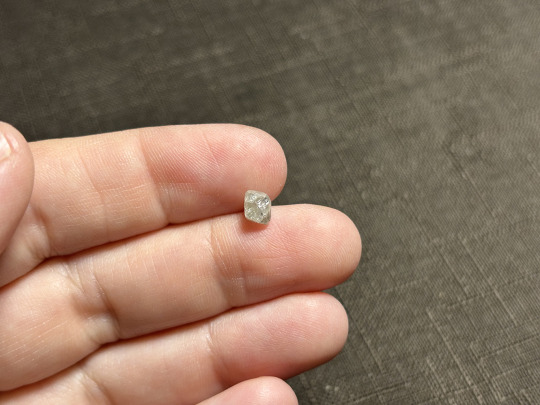
Here's the most expensive piece I came home with - a South African diamond! Can you believe I didn't have a diamond in my collection yet? That problem has been remedied.

It fluoresces!

And finally, my friends and I broke open a few geodes at the geode-cracking booth. I picked out some Trancas geodes from Mexico.




This locale produces weird, wavy, wormy crystals! These formations occur when quartz (in the form of chalcedony or hyalite) grows atop hair-thin, curly crystals of anhydrite.

They fluoresce!
And that was my haul from the rock show!
#rock collecting#red pen has cool rocks#tully monster#dinosaur bone#coprolite#stromatolite#turritella agate#rain flower agate#afghanite#vesuvianite#zircon#anatase#diamond#geodes#fluorescence
346 notes
·
View notes
Text
Round 3 - Reptilia - Gruiformes


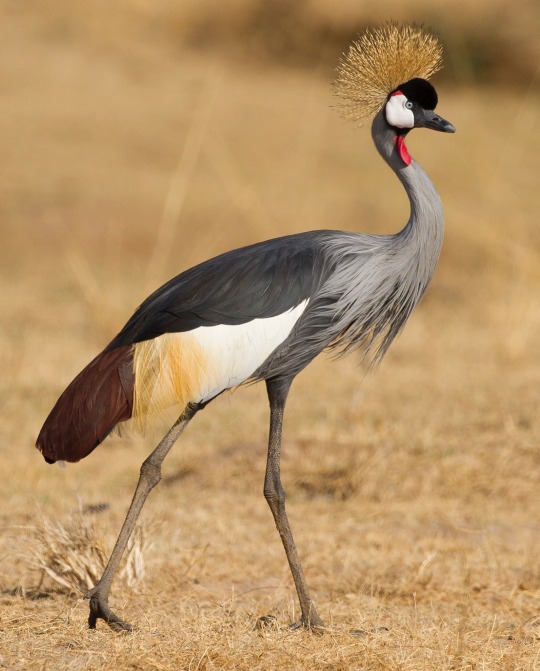

(Sources - 1, 2, 3, 4)
Our next order of birds are the Gruiformes, a diverse order with a widespread geographical diversity. “Gruiform” means “crane-like”, even though the majority of gruiformes are rails. Gruiformes contains the families Psophiidae (“trumpeters”), Aramidae (“Limpkin”), Gruidae (“cranes”), Rallidae (“rails”, “coots”, and “crakes”), Heliornithidae (“finfoots”), and Sarothruridae (“flufftails”).
Gruiformes are terrestrial or wading birds with a considerable amount of diversity. The Trumpeters (genus Psophia) (image 1) are rotund birds with long, flexible necks and legs, downward-curving bills, soft plumage, large eyes, and a “hunched” appearance. They are weak fliers but fast runners, and can also swim across rivers. The cranes (Gruidae) (image 3 and gif below) and the Limpkin (Aramus guarauna) are long-necked, long-legged, long-beaked waders, some of which are the world’s tallest flying birds. Their plumage varies by habitat. The Rallidae (image 4) are the most diverse family of Gruiformes. Many are associated with wetland habitats, some being semi-aquatic like waterfowl (such as the coot), and some being more like wading birds or shorebirds. The finfoots (Heliornithidae) resemble rails; they have long necks, slender bodies, broad tails, and sharp, pointed bills. Their legs and feet are brightly coloured and they are capable of walking well and even moving quickly on land. The flufftails (Sarothruridae) (image 2) are small- to medium-sized ground-living birds. Due to the diversity of this order, it is difficult to summarize them further!
Gruiformes evolved in the Paleocene, around 60 million years ago.
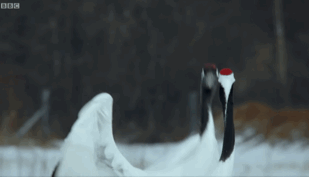
(source)
Propaganda under the cut:
Grey-winged Trumpeters (Psophia crepitans) are polyandrous and cooperative breeders. Up to three males mate with the dominant female of the flock, and all members of the flock contribute to raising the young.
One of the handful of non-avian dinosaurs we know the colors of is the Late Jurassic Caihong juji. Thanks to some exquisitely fossilized melanosomes (pigment cells) within the animals feathers, paleontologists were able to determine Caihong’s coloration by comparing it to those of living birds. The sheets of platelet-like melanosomes were solid and lacked air bubbles, and were thus most similar to the iridescent feathers that exist in modern Trumpeters (genus Psophia). It is thanks to trumpeters for preserving this type of melanosome, that we know the appearance of a dinosaur from the Late Jurassic!
The Limpkin (Aramus guarauna) has a beak that is slightly open near the end, giving it a tweezer-like action to remove their main prey, Apple Snails (family Ampullariidae), from their shells. In many individuals the tip of their beak curves slightly to the right, matching the Apple Snails’ shells.
Most species of cranes have been affected by human activities and are at the least classified as threatened, if not critically endangered. The plight of the Whooping Crane (Grus americana) of North America inspired some of the first US legislation to protect endangered species. After being pushed to the brink of extinction due to unregulated hunting and loss of habitat, just 21 wild (and two captive) Whooping Cranes remained by 1941. Thanks to conservation efforts, the total number of cranes in the surviving migratory population, including those in captivity, only slightly exceeds 911 birds as of 2020.
The Sanskrit epic poet Valmiki was inspired to write the first śloka couplet by the pathos of seeing a male Sarus Crane (Antigone antigone) shot while dancing with its mate.
The endangered South Island Takahē (Porphyrio hochstetteri) is a flightless swamphen indigenous to New Zealand. Takahē were hunted extensively by both early European settlers and Māori, and takahē's bones, as well as fossil remains, have been found in middens in the South Island. They were not named and described by Europeans until 1847, and then only from fossil bones. In 1850 a living bird was captured, and three more collected in the 19th century. After another bird was captured in 1898, and no more were to be found, the species was presumed extinct. Fifty years later, however, after a carefully planned search, South Island Takahē were dramatically rediscovered in November 1948 by Geoffrey Orbell in an isolated valley in the South Island's Murchison Mountains. Since then, takahē have been reintroduced to numerous locations across the country. As of 2023, the population is around 500 and is growing by 8% per year.
The Guam Rail (Hypotaenidia owstoni) came perilously close to extinction when Brown Tree Snakes (Boiga irregularis) were introduced to Guam, but some of the last remaining individuals were taken into captivity and have been breeding well. They have since been successfully introduced to the nearby Rota and Cocos islands, as the Brown Tree Snakes have yet to be eradicated in Guam. In 2019, the Guam Rail became the second bird species to be reclassified by the International Union for the Conservation of Nature from Extinct in the Wild, to Critically Endangered.
#sorry if there are any mistakes here and if it’s a bit short#it’s midnight and I’m fighting sleep to finish this#animal polls#round 3#reptilia#Gruiformes
83 notes
·
View notes
Text

🎪 4 of 5 - Gifting
WC: ~450 Warnings: nsfw, Buggy x GN!reader, oral (kinda) - reader receiving
💌 #hey-august valentines 2025

First it was a fresh drink of ale. And a hand pie that was still steaming when you bit into it.
After visiting an island with netted seats hanging from trees along the seaside where you spent multiple afternoons, Buggy had hammock chairs installed on the ship’s deck.
One morning you woke up to a notebook and pen. Behind the flyleaf was your name, written in Buggy’s scratchy handwriting. Buggy liked how the pen’s ink was the same color of your eyes, even down to the shimmer that made the stars envious.
Buggy made a meal that you mentioned months ago. Your grandma would make a stew that was swimming with strong flavors and aromas - ginger and black peppercorns, salt from the soy sauce, and vinegar. You only mentioned it because Buggy’s pits were so fragrant that the tang reminded you of how heavy handed your grandma was with the vinegar when she cooked.
That meal tasted like home.
Whenever you visited beaches during the journey’s pause, you would walk with the sea on one side and Buggy on the other. For a while. Eventually the pirate would stop walking and do everything else. He’d kick aside rocks, flip driftwood, pick up unknown treasures only to toss them over his shoulder - all while talking to you about everything and nothing.
And back on the ship, at the end of the day, Buggy would empty his pockets of all the things he brought back for you. The abandoned home of a sea snail. Small shells with holes drilled in them by hungrier creatures. Wishing stones that Buggy would hold up excitedly and show you the completed stripe. Little fossils in the shape of stars, which ended up everywhere. Sand dollars. Sea glass in all hues. And one time, a cowrie shell with a very confused hermit crab.
There are also the gifts that Buggy benefits from, as well.
All sorts of fresh fruit that he cuts bite by bite, with each slice alternating between your mouth and his. A wedge of apple for you and one for him. Pineapple so juicy that he has to swipe a drop of nectar off your bottom lip with his thumb. Plump grapes with skin that snaps. Peaches that would bruise if you look at them for too long. Bananas that Buggy hands to you - uncut and with a wink.
And the clothing. Especially the collection of undergarments that doesn’t outgrow the storage space, only because of how often they end up ruined. Lipstick marks that won’t wash away. Ones that are torn off by hands, teeth, or blades. Cumstains.
Buggy’s favorite are the ones made of silk. He likes how you shiver against the cool fabric. He watches every goofy dance you do when putting them on, enjoying your silly show of appreciation. He chooses items that are made for your body. Ones that drape exactly where they should. That hug you just right. That show off your assets while still keeping things hidden.
He also likes watching you make a mess of your underwear. The wet spot that grows along with your excitement is a treat for him. Literally. Buggy will get you worked up with hungry kisses that leave you breathless and drooling. He’ll say naughty things and offer the sweetest promises. He’ll make you repeat every word he’s said, until you’re pleading and begging for more filth than what came from his lips.
And when your gift is soaking wet and you're about to take matters into your own hands, the gift changes owners. With his hands on your wrists and his face between your legs, Buggy is sucking your taste from the fabric. Your arousal is replaced with his spit.
The thin fabric lets you feel plenty and not enough. You can feel the heat from his mouth and the vibrations from his moaning, but not his breath. His tongue presses hard and the pressure is delightful, but not better than feeling the rough, wet affection directly.
Yes, Buggy likes to give you gifts. But when it’s his turn to enjoy one, he’s going to take his time.
#buggy smut#buggy x reader#buggy the clown x reader#buggy the clown#buggy x you#x reader#buggy op#opla buggy#one piece buggy#buggy the clown smut#one piece smut#hey-august buggy short stories#hey-august valentines 2025
65 notes
·
View notes
Text

🐚 My Shell List for Ocean Witchcraft
very long!
Cowrie Shell -- Prosperity, fertility, feminine energy, wealth - where to collect: Africa, Indian Ocean beaches
Scallop Shell -- Journey, pilgrimage blessings, protection - where to collect: Atlantic beaches (USA, Europe)
Conch Shell -- Call to spirits, awakening inner power, amplifying voice - where to collect: Caribbean, warm tropical beaches
Sand Dollar -- Spiritual rebirth, peace, trust in universal cycles - where to collect: Mexico, Florida, tropical sandy shores
Murex Shell -- Royalty, sacredness, defense magic - where to collect: Mediterranean, Indo-Pacific
Olive Shell -- Grace, smooth paths, grounding wishes - where to collect: Southeastern US, Australia
Auger Shell -- Psychic defense, focus, clarity - where to collect: Indo-Pacific, Florida, warm beaches
Wentletrap Shell -- Spirit communication, delicate energy, accessing dreams - where to collect: Shallow waters, Southeast Asia
Babylon Shell -- Abundance, rootedness, wisdom of ancestors - where to collect: Persian Gulf, India, Philippines
Triton’s Trumpet -- Powerful protection, summoning sea spirits, strength - where to collect: Indo-Pacific reefs, coral-heavy shores
Limpet Shell -- Adaptability, steady progress, emotional protection - where to collect: Rocky shores, tide pools worldwide
Nerite Shell -- New beginnings, resisting negativity, safe travels - where to collect: Caribbean, Florida, Indo-Pacific
Moon Snail Shell -- Intuition, hidden wisdom, psychic dreams - where to collect: Pacific Northwest (USA), colder beaches
Top Shell -- Personal growth, creativity, positive flow - where to collect: Mediterranean, Caribbean
Turritella Shell -- Ancient memory, ancestral connection, earth-sea balance - where to collect: Fossil beds, warm shallow waters
Sundial Shell (Architectonica perspectiva) -- Cosmic connection, time magic, spiraling growth - where to collect: Indo-Pacific, sandy shallow areas
Helmet Shell (some of my favorites!) -- Courage, spiritual shielding, warrior energy - where to collect: Indo-Pacific, Caribbean
Volute Shell -- Love, devotion, honoring vows (Great gift for your partner <3) - where to collect: Warm waters, Indian Ocean
Paper Nautilus (Argonaut Shell) -- Creativity, femininity, magical flight - where to collect: These are rarer than most, and they float! Mediterranean, Australia
Angel Wing Shell -- Fragile beauty, spiritual awakening, connection to dreams - where to collect: Gulf of Mexico, Florida, Caribbean
Slipper Limpet -- Subtle healing, balance between giving and receiving - where to collect: European and East Coast shores
Donax Shell (Coquina) -- Energy shifts, playfulness, social magic - where to collect: Southeastern USA beaches
Cockle Shell -- Friendship, love, carrying home’s blessings - where to collect: European beaches, Atlantic shores
Pheasant Shell -- Endurance, adaptability, balance of inner and outer selves - where to collect: Australia, New Zealand, Pacific beaches
Spindle Shell -- Manifestation of goals, swift change, ambition - where to collect: Indo-Pacific region, tropical beaches
Marginella Shell -- Financial luck, small blessings, quick positive changes - where to collect: West Africa, Indian Ocean
Ark Shell (clam) -- Courage to face emotional challenges, opening the heart - where to collect: East Coast USA, Gulf of Mexico
Cat’s Eye Shell (Operculum) (My favorite!!!) -- Spiritual gateway, protection during astral travel - where to collect: Washed up with dead shells (Sri Lanka, Australia)
Button Top Shell -- Inner balance, softening harsh emotions, emotional maturity - where to collect: Caribbean, Indo-Pacific
✨ Tips for Collecting Shells
Respect local laws: Some places protect shells, corals, and marine wildlife! Always check if it's okay to take them.
Ethical gathering: Only take empty, dead shells (never with a creature still inside).
Cleanse shells: Wash gently with water and sea salt before using them in spells or altars.
🐚 Shell Magic Ideas
Use cowrie shells in money bowls.
Sand dollars are amazing for transformation rituals.
Conch shells can be used as literal horns to call spirits or start a ritual.
Tiny auger shells make great protection charms to wear or carry.
Paper nautilus shells (if you can find one!!) are perfect for creativity and dream weaving magic.
other sites to use: Shelling tips , shell hunting in Texas , Where and when to find shells
Note: some shells match certain moon phases! Do extra research before using, and make sure the ones you're taking aren't still alive or home to a hermit crab! that can be a miniature trouble! especially if the snail inside is possibly poisonous or venomous.
#shells#sea shells#seashells#aquatic#pagan witch#witch#witch community#witchblr#witches#witchy#witchcraft#witchy vibes#wicca#wiccan#pagan#witches of tumblr#sea witch#ocean witch#ocean witchcraft#ocean water#ocean world#ocean shells#where to find#seashell#Sand dollar#tips#cowrie#scallop#conch#sealife
29 notes
·
View notes
Text
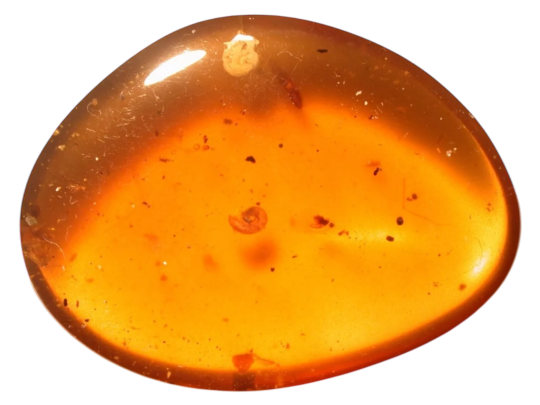
2 Snails with Millipede Insects in Burmite Burmese Amber Fossil
#snail#snail fossil#snail shell#millipede#bug#bug fossil#insect#fossil insect#amber fossil#Amber#fossil#fossils#bugs#png#transparent#ebay#paleontology#prehistoric
99 notes
·
View notes
Text

Busycon fossil snail shell geode lined with yellowish calcite crystals from the Quaternary of Florida, USA. (entire rock specimen is 11 cm across)
27 notes
·
View notes
Photo

Fossil Gastropods – Ampullina & Clavilithes willemetti (Dehayes) – Middle Eocene, Lutetian – Mourne, Damery, France
Authentic Fossil Gastropods – Ampullina & Clavilithes willemetti (Dehayes) – Middle Eocene, Lutetian – Mourne, Damery, France
About the Fossils:
This is a high-quality fossil gastropod specimen featuring Ampullina and Clavilithes willemetti (Dehayes), preserved from the Middle Eocene Lutetian stage (~48-41 million years ago). These beautifully fossilized marine snails were part of an ancient warm-sea ecosystem that flourished in what is now Mourne, Damery, France.
The Ampullina genus is known for its rounded, smooth shell structure, while Clavilithes willemetti features a more elongated, ornate form. These gastropods belonged to the rich and diverse marine fauna of the Eocene epoch, thriving in tropical and subtropical seas.
Geology & Formation:
Geological Age: Middle Eocene, Lutetian (~48-41 million years ago)
Formation: Marine sedimentary deposits
Location: Mourne, Damery, France
Preservation: Excellent fossilization, showcasing intricate shell details
Why This Fossil?
✔ 100% Genuine Specimen – Comes with a Certificate of Authenticity
✔ Highly Collectible – From the renowned Alice Purnell Collection
✔ Perfect for Display or Study – Ideal for fossil collectors, students, and paleontology enthusiasts
✔ Scale Rule/Cube = 1cm – See photos for full sizing
The fossil in the photo is the exact specimen you will receive!
Secure Packaging & Fast Shipping – Your fossil will be carefully packed for a safe journey!
#Fossil Gastropods#Ampullina fossil#Clavilithes willemetti#Eocene gastropod#Lutetian fossil#Mourne fossils#Damery fossils#France fossils#marine fossils#prehistoric shell#mollusk fossil#fossilized snail#rare gastropod#paleontology#fossil collection#fossil hunting#ammonite collection#genuine fossil#Alice Purnell Collection
2 notes
·
View notes
Text
Fossil Friday: Campanile giganteum

One of our surprisingly popular March Madness competitors, Campanile giganteum is marine snail from the Paris Basin of France during the Eocene Epoch 56-33.9 Ma. It was first described by the famous Jean-Baptiste Lamarck in 1804, He initially had it in the genus Cerithium, which, to be fair, doesn't look a whole lot different.

It was found in the Lutetian limestone (Calcaire lutecian) also known as the Paris Stone. This formation consists of a freshwater limestone deposited on top of a marine limestone as well as some minor calcareous and glauconitic sandstones. This suggests an open, shallow subtidal zone.
This giant snail lived alongside other invertebrates like foraminiferans,
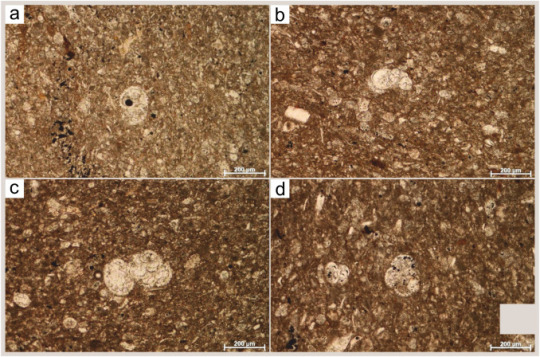
a bivalve called Crassatella,
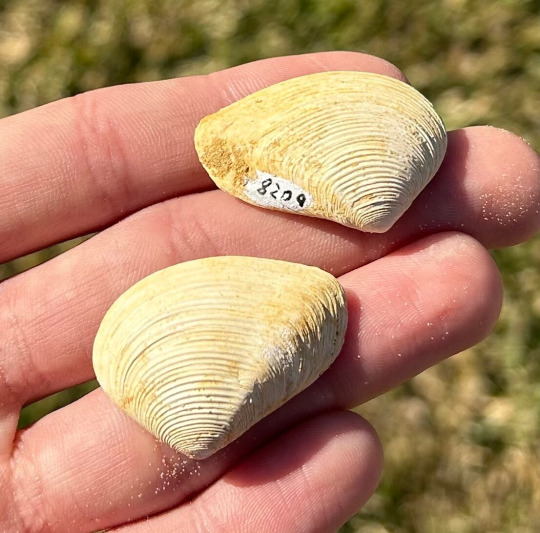
other snails,
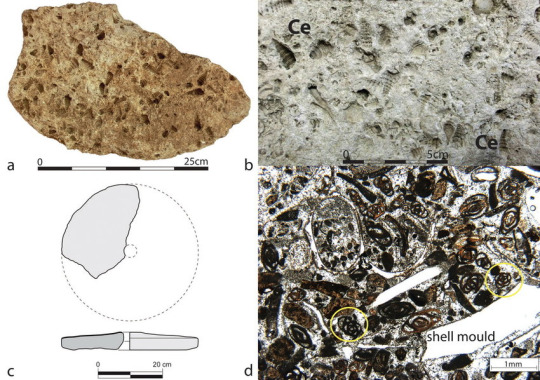
and marine worms.
C. giganteum is actually only one species of many within the genus Campanile. it belongs in the phylum Mollusca which includes snails, cephalopods and bivalves.
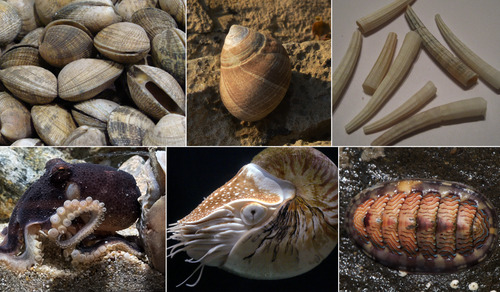
From there they belong in the class gastropoda, commonly known as snails and slugs.

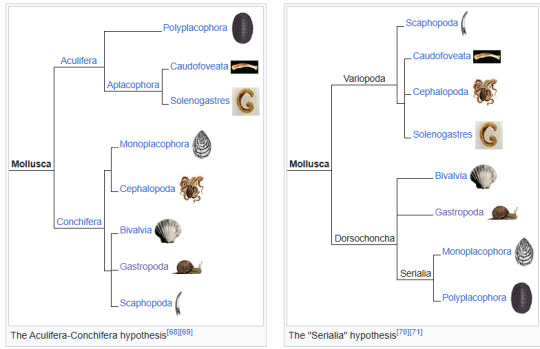
There's currently a bit of debate going on with taxonomy further down, but there are at least 18 named species of Campanile including one living species C. symbolicum whose common name is the Bell Clapper or Giant Creeper. It lives in coastal waters off southwestern Australia.
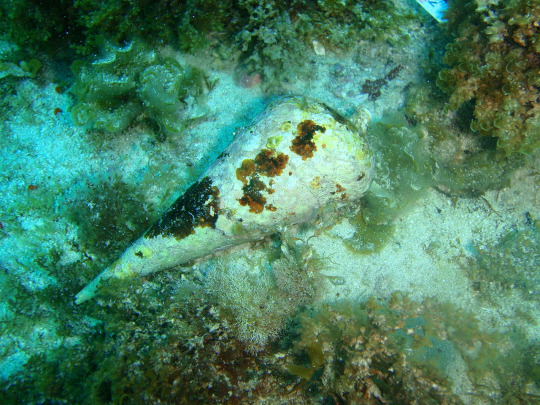
C. giganteum was the largest gastropod to have lived (as far as we know). It got up to 35 in (90cm) on average. C. symbolicum only gets to a little less than 10 inches (24 cm).
A study was done in 2020 on C. giganteum in regard to growth and paleoseasonality. They found that C. giganteum grew upwards of 600 mm per year along the helix of their shell. They concluded that it lived in water between 21-32 degrees Celsius (69.8-89.6 degrees F) which really isn't all that different from the Mediterranean Sea today (a little warmer). If you want to read more about this study, here's the link:
https://agupubs.onlinelibrary.wiley.com/doi/full/10.1029/2019GC008794
Make sure you tune in Monday as we talk more about different types of igneous rocks! Fossilize you later!

27 notes
·
View notes
Note
YES beachcomber would be such a collector of rocks and minerals and show them to his human friends. Especially unique ones like fulgurites
Him sharing all his different rocks he's collected with you and you sharing your different seashells with him.~ <3
I think he'd be REALLY into fossils and amber too. The idea that over time a once-living organic creature can slowly but surely become an indelible mineral, a snapshot of a bygone era, is deeply fascinating to him.

"This one's called a cowrie shell." The shell that fit so snugly in the palm of your hand is dwarfed in Beachcomber's massive servo, but he still handles it with incredible care. "This one's on the bigger side, but small ones used to be used as currency in different parts of the world."
"It's beautiful. And it ain't polished or anything like that?"
"Nope! Sometimes you'll find them covered in salt in the water if they've been there for a while, but while it's alive the snail inside keeps the shell shiny and clean. Not all shells are like that, though."
You can tell you've piqued Beachcomber's curiosity, so you quickly take the next shell you've brought out of your bag. "This is an abalone shell. The rough outside helps them to camouflage with coral and rocks. But on the inside..."
You turn the iridescent inner shell to Beachcomber's gaze, and his faceplate lights up with awe.
"It's beautiful."
You take the cowrie from his servo and press the abalone into it. He cradles it so tenderly, rocking it gently back and forth to catch the rays of light bouncing off the glistening, pearlescent interior. Before knowing the Autobots, you wouldn't have expected their stern metal faces to be capable of this level of soft sincerity. How foolish you were, back then.
"We could go shell-hunting sometime, if you'd like!" You add. "I can show you where I found some of my collection, see if we find anything good?"
He turns his attention back to you, his voice low, smooth, and achingly tender.
"I'd like that very much."
#transformers#transformers x reader#beachcomber#beachcomber x reader#x reader#tf beachcomber#g1 beachcomber#maccadam#pink chat#marsnolias
129 notes
·
View notes
Text

Shout out to whatever made this hole in Cloudina, congratulations on being the first animal who realized you could eat other animals
(Explanation: Cloudina is a fossil of uncertain affinity that lived at the very end of the Ediacaran period, some 550 million years ago, just before the Cambrian began. It and some contemporaries are the oldest organisms known with a shell. A fossil of Cloudina shows a hole similar to the one predatory snails make on bivalve shells, which makes it AFAIK the oldest evidence of active predation.)
33 notes
·
View notes